An Optimal Sizing of Stand-Alone Hybrid PV-Fuel Cell-Battery to Desalinate Seawater at Saudi NEOM City
Abstract
:1. Introduction
2. Location of Case Study
3. Seawater Desalination Plant
4. Description of Different Components of the System
4.1. Solar PV Cells
4.2. Fuel Cell
4.3. Battery System
4.4. Converter
4.5. Electrolyzer
4.6. Hydrogen Storage Tank
5. Evaluation Criteria
6. Results and Discussion
7. Comparison with Utility Extension
8. Conclusions
Author Contributions
Funding
Acknowledgments
Conflicts of Interest
References
- Saudi Aramco’s First-half 2019 Financial Reports, for the Six Months Ended June 30, 2019. Available online: https://www.saudiaramco.com (accessed on 14 February 2020).
- Saudi Arabia’s Vision 2030. Available online: https://vision2030.gov.sa (accessed on 17 February 2020).
- DeNicola, E.; Aburizaiza, O.S.; Siddique, A.; Khwaja, H.; Carpenter, D.O. Review: Climate Change and Water Scarcity: The Case of Saudi Arabia. Ann. Glob. Health 2015, 81. [Google Scholar] [CrossRef]
- Aly, H. Royal Dream: City Branding and Saudi Arabia’s NEOM. Middle East Topics Argum. 2019. [Google Scholar] [CrossRef]
- Farag, A.A. The Story of NEOM City: Opportunities and Challenges. In New Cities and Community Extensions in Egypt and the Middle East: Visions and Challenges; Chapter in Book; Attia, S., Shafik, Z., Ibrahim, A., Eds.; Springer: Cham, Switzerland, 2019; ISBN 978-3-319-77874-7. [Google Scholar] [CrossRef]
- Alkaisi, A.; Mossad, R.; Sharifian-Barforoush, A. A review of the water desalination systems integrated with renewable energy. Energy Procedia 2017, 110, 268–274. [Google Scholar] [CrossRef]
- Gude, V.G. Renewable Energy Powered Desalination Handbook: Application and Thermodynamics; Butterworth-Heinemann: Oxford, UK, 2018; ISBN 978-0-12-815244-7. [Google Scholar] [CrossRef]
- Hasan, E. Desalination Integration with Renewable Energy for Climate Change Abatement in the MENA Region. Recent Prog. Desalin. Environ. Mar. Outfall Syst. 2015, 1, 159–173. [Google Scholar] [CrossRef]
- Xevgenos, D.; Moustakas, K.; Malamis, D.; Loizidou, M. An overview on desalination and sustainability: Renewable energy-driven desalination and brine management. Desalin. Water Treat. 2016, 57, 2304–2314. [Google Scholar] [CrossRef]
- Ruiz-García, A.; Melián-Martel, N.; Nuez, I. Short Review on Predicting Fouling in RO Desalination. Membranes 2017, 7, 62. [Google Scholar] [CrossRef] [Green Version]
- Melián-Martel, N.; Alonso, J.; Ruiz-García, A. Combined silica and sodium alginate fouling of spiral-wound reverse osmosis membranes for seawater desalination. Desalination 2018, 439, 25–30. [Google Scholar] [CrossRef]
- Abdel-Salam, M.; Ahmed, A.; Ziedan, H.; Sayed, K.; Amery, M.; Swify, M. A Solar-wind Hybrid Power System for Irrigation Toshka Area. In Proceedings of the 2011 IEEE Jordan Conference on Applied Electrical Engineering and Computing Technologies (AEECT), Amman, Jordan, 6–8 December 2011. [Google Scholar] [CrossRef]
- Rezk, H.; Abdelkareemc, M.A.; Ghenai, C. Performance evaluation and optimal design of stand-alone solar PV-battery system for irrigation in isolated regions: A case study in Al Minya (Egypt). Sustain. Energy Technol. Assess. 2019, 36, 100556. [Google Scholar] [CrossRef]
- Rezk, H.; Sayed, E.T.; Al-Dhaifallah, M.; Obaid, M.; El-Sayed, A.H.M.; Abdelkareem, M.A.; Olabi, A.G. Fuel cell as an effective energy storage in reverse osmosis desalination plant powered by photovoltaic system. Energy 2019, 175, 423–433. [Google Scholar] [CrossRef] [Green Version]
- Mohamed, M.A.; Diab, A.A.Z.; Rezk, H. Partial shading mitigation of PV systems via different meta-heuristic techniques. Renew. Energy 2019, 130, 1159–1175. [Google Scholar] [CrossRef]
- Abdalla, O.; Rezk, H.; Ahmed, E.M. Wind driven optimization algorithm based global MPPT for PV system under non-uniform solar irradiance. Sol. Energy 2019, 180, 429–444. [Google Scholar] [CrossRef]
- Sarma, U.; Ganguly, S. Design optimisation for component sizing using multi-objective particle swarm optimisation and control of PEM fuel cell-battery hybrid energy system for locomotive application. Iet Electr. Syst. Transp. 2020, 10, 52–61. [Google Scholar] [CrossRef]
- Vijay, A.; Hawkes, A. Impact of dynamic aspects on economics of fuel cell based micro co-generation in low carbon futures. Energy 2018, 155, 874–886. [Google Scholar] [CrossRef]
- Abdelkareem, M.A.; Allagui, A.; Sayed, E.T.; El Haj, A.M.; Said, Z.; Elsaid, K. Comparative analysis of liquid versus vapor-feed passive direct methanol fuel cells. Renew. Energy 2019, 131, 563–584. [Google Scholar] [CrossRef]
- Zhang, X.; Chan, S.H.; Ho, H.K.; Tan, S.C.; Li, M.; Li, G.; Li, J.; Feng, Z. Towards a smart energy network: The roles of fuel/electrolysis cells and technological perspectives. Int. J. Hydrog. Energy 2015, 40, 6866–6919. [Google Scholar] [CrossRef]
- Ameri, M.; Yoosefi, M. Power and fresh water production by solar energy, fuel cell, and reverse osmosis desalination. J. Renew. Energy Environ. 2016, 3, 25–34. [Google Scholar]
- Rehman, S.; Habib, H.U.R.; Wang, S.; Büker, M.S.; Alhems, L.M.; Al Garni, H.Z. Optimal Design and Model Predictive Control of Standalone HRES: A Real Case Study forResidential Demand Side Management. IEEE Access 2020. [Google Scholar] [CrossRef]
- Al-Ammar, E.A.; Habib, H.U.R.; Kotb, K.M.; Wang, S.; Ko, W.; Elmorshedy, M.F.; Waqar, A. Residential Community Load Management Based on Optimal Design of Standalone HRES With Model Predictive Control. IEEE Access 2020, 8. [Google Scholar] [CrossRef]
- Shafik, M.B.; Rashed, G.I.; Chen, H. Optimizing Energy Savings and Operation of Active Distribution Networks Utilizing Hybrid Energy Resources and Soft Open points: Case Study in Sohag, Egypt. IEEE Access 2020. [Google Scholar] [CrossRef]
- Ziedan, H.A.; Elbaset, A.A.; Mourad, A.N. Optimization of PV/Wind Power System: Case study: Supplying Large Industry Load in Egypt. J. Eng. Appl. Sci. 2020, 15, 1014–1020. [Google Scholar] [CrossRef] [Green Version]
- Al-Ghussain, L.; Samu, R.; Taylan, O.; Fahrioglu, M. Sizing Renewable Energy Systems with Energy Storage Systems in Microgrids for Maximum Cost-Efficient Utilization of Renewable Energy Resources. Sustain. Cities Soc. 2020, 102059. [Google Scholar] [CrossRef]
- Habib, H.U.R.; Wang, S.; Elkadeem, M.R.; Elmorshedy, M.F. Design Optimization and Model Predictive Control of a Standalone Hybrid Renewable Energy System: A Case Study on a Small Residential Load in Pakistan. IEEE Access 2019, 7. [Google Scholar] [CrossRef]
- Fodhil, F.; Hamidat, A.; Nadjemi, O. Potential, optimization and sensitivity analysis of photovoltaic-diesel-battery hybrid energy system for rural electrification in Algeria. Energy 2019, 169, 613–624. [Google Scholar] [CrossRef]
- Jahangiri, M.; Haghani, A.; Shamsabadi, A.; Mostafaeipour, A.; Pomares, L.M. Feasibility study on the provision of electricity and hydrogen for domestic purposes in the south of Iran using grid-connected renewable energy plants. Energy Strategy Rev. 2019, 23, 23–32. [Google Scholar] [CrossRef]
- Aziz, A.S.; Tajuddin, M.F.N.; Adzman, M.R.; Azmi, A.; Ramli, M.A. Optimization and sensitivity analysis of standalone hybrid energy systems for rural electrification: A case study of Iraq. Renew. Energy 2019, 138, 775–792. [Google Scholar] [CrossRef]
- Aziz, A.S.; Tajuddin, M.F.N.; Adzman, M.R.; Ramli, M.A.; Mekhilef, S. Energy management and optimization of a PV/diesel/battery hybrid energy system using a combined dispatch strategy. Sustainability 2019, 11, 683. [Google Scholar] [CrossRef] [Green Version]
- Acevedo-Arenas, C.Y.; Correcher, A.; Sánchez-Díaz, C.; Ariza, E.; Alfonso-Solar, D.; Vargas-Salgado, C.; Petit-Suárez, J.F. MPC for optimal dispatch of an AC-linked hybrid PV/wind/biomass/H2 system incorporating demand response. Energy Convers. Manag. 2019, 186, 241–257. [Google Scholar] [CrossRef]
- Awan, A.B. Performance analysis and optimization of a hybrid renewable energy system for sustainable NEOM city in Saudi Arabia. J. Renew. Sustain. Energy 2019, 11. [Google Scholar] [CrossRef]
- Akar, O.; Terzi, Ü.K.; Tunçalp, B.K.; Sönmezocak, T. Determination of the Optimum Hybrid Renewable Power System: A case study of Istanbul Gedik University Gedik Vocational School. Balk. J. Electr. Comput. Eng. 2019, 7. [Google Scholar] [CrossRef]
- Oladigbolu, J.O.; Ramli, M.A.; Al-Turki, Y.A. Techno-Economic and Sensitivity Analyses for an Optimal Hybrid Power System Which is Adaptable and Effective for Rural Electrification: A Case Study of Nigeria. Sustainability 2019, 11, 4959. [Google Scholar] [CrossRef] [Green Version]
- Goudarzi, S.A.; Fazelpour, F.; Gharehpetian, G.B.; Rosen, M.A. Techno-economic assessment of hybrid renewable resources for a residential building in Tehran. Environ. Prog. Sustain. Energy 2019, 38, 13209. [Google Scholar] [CrossRef]
- Shaahid, S.M.; Alhems, L.M.; Rahman, M.K. Techno-economic assessment of establishment of wind farms in different Provinces of Saudi Arabia to mitigate future energy challenges. Therm. Sci. 2019, 23, 2909–2918. [Google Scholar] [CrossRef] [Green Version]
- Alyahya, S.; Irfan, M. Analysis from the New Solar Radiation Atlas for Saudi Arabia. Sol. Energy 2016, 130, 116–127. [Google Scholar] [CrossRef]
- NASA. Surface Meteorology and Energy. Available online: https://power.larc.nasa.gov (accessed on 17 February 2020).
- Rezk, H.; Dousoky, G.M. Technical and economic analysis of different configurations of stand-alone hybrid renewable power systems—A case study. Renew. Sustain. Energy Rev. 2017, 62, 941–953. [Google Scholar] [CrossRef]
- Rezk, H.; Shoyama, M. Techno-economic optimum sizing of stand-alone photovoltaic/fuel cell renewable system for irrigation water pumping applications. In Proceedings of the IEEE International Conference on Power and Energy (PECon), Kuching, Sarawak, Malaysia, 1–3 December 2014; pp. 182–186. [Google Scholar]
- Said, M.M.; El-Aassar, A.M.; Kotp, Y.H.; Shawky, H.A.; Abdel Mottaleb, M.S. Performance assessment of prepared polyamide thin film composite membrane for desalination of saline groundwater at Mersa Alam-Ras Banas, Red Sea Coast, Egypt. Desalin. Water Treat. 2013. [Google Scholar] [CrossRef]
- Singh, O.; Turkiya, S. A survey of household domestic water consumption patterns in rural semi-arid village, India. GeoJournal 2013, 78, 777–790. [Google Scholar] [CrossRef]
- MAK Water. Available online: https://www.makwater.com.au/products/sea-water-reverse-osmosis/ (accessed on 17 February 2020).
- Ruiz-García, A.; Nuez, I. Long-term performance decline in a brackish water reverse osmosis desalination plant. Predictive model for the water permeability coefficient. Desalination 2016, 397, 101–107. [Google Scholar] [CrossRef] [Green Version]
- Kim, J.; Park, K.; Yang, D.R.; Honga, S. A comprehensive review of energy consumption of seawater reverse osmosis desalination plants. Appl. Energy 2019, 254, 113652. [Google Scholar] [CrossRef]
- Ruiz-García, A.; Feo-García, J. Operating and maintenance cost in seawater reverse osmosis desalination plants. Artificial neural network based model. Desalin. Water Treat. 2017, 73, 73–79. [Google Scholar] [CrossRef]
- Abo-Elyousr, F.K.; Nozhy, A.N. Bi-objective Economic Feasibility of Hybrid Micro-Grid Systems with Multiple Fuel Options for Islanded Areas in Egypt. Renew. Energy 2018. [Google Scholar] [CrossRef]
- Rosewater, D.M.; Copp, D.A.; Nguyen, T.A.; Byrne, R.H.; Santoso, S. Battery Energy Storage Models for Optimal Control. IEEE Access 2019, 7, 178357–178391. [Google Scholar] [CrossRef]
- Dursun, B.; Aykut, E. An investigation on wind/PV/fuel cell/battery hybrid renewable energy system for nursing home in Istanbul. J. Power Energy Part A 2019. [Google Scholar] [CrossRef]
- Li, C. Techno-economic study of off-grid hybrid photovoltaic/battery and photovoltaic/battery/fuel cell power systems in Kunming, China. Energy Sources Part A Recovery Util. Environ. Eff. 2018. [Google Scholar] [CrossRef]
- Sayed, K.; Gronfula, M.G.; Ziedan, H.A. Novel Soft-Switching Integrated Boost DC-DC Converter for PV Power System. Energies 2020, 13, 749. [Google Scholar] [CrossRef] [Green Version]
- Nejati, S.; Mirbagheri, S.A.; Warsinger, D.M.; Fazeli, M. Biofouling in seawater reverse osmosis (SWRO): Impact of module geometry and mitigation with ultrafiltration. J. Water Process Eng. 2019, 29, 100782. [Google Scholar] [CrossRef]
- Feo-García, J.; Ruiz-García, A.; Ruiz-Saavedra, E.; Melian-Martel, N. Energy consumption assessment of 4000 m3/d SWRO desalination plants. Desalin. Water Treat. 2016, 57, 23019–23023. [Google Scholar] [CrossRef]
- Saudi Electricity Company. Available online: https://www.se.com.sa (accessed on 14 February 2020).

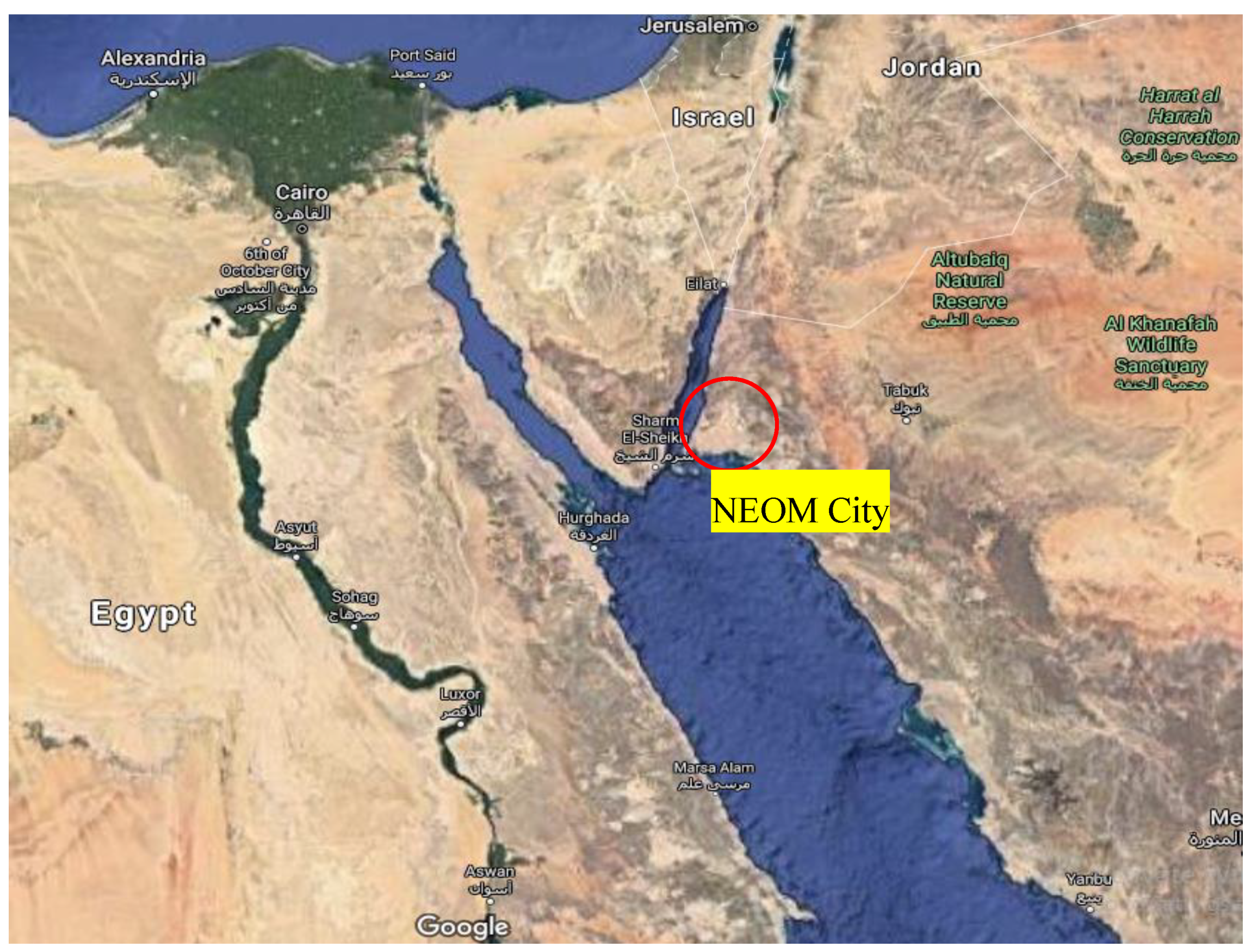
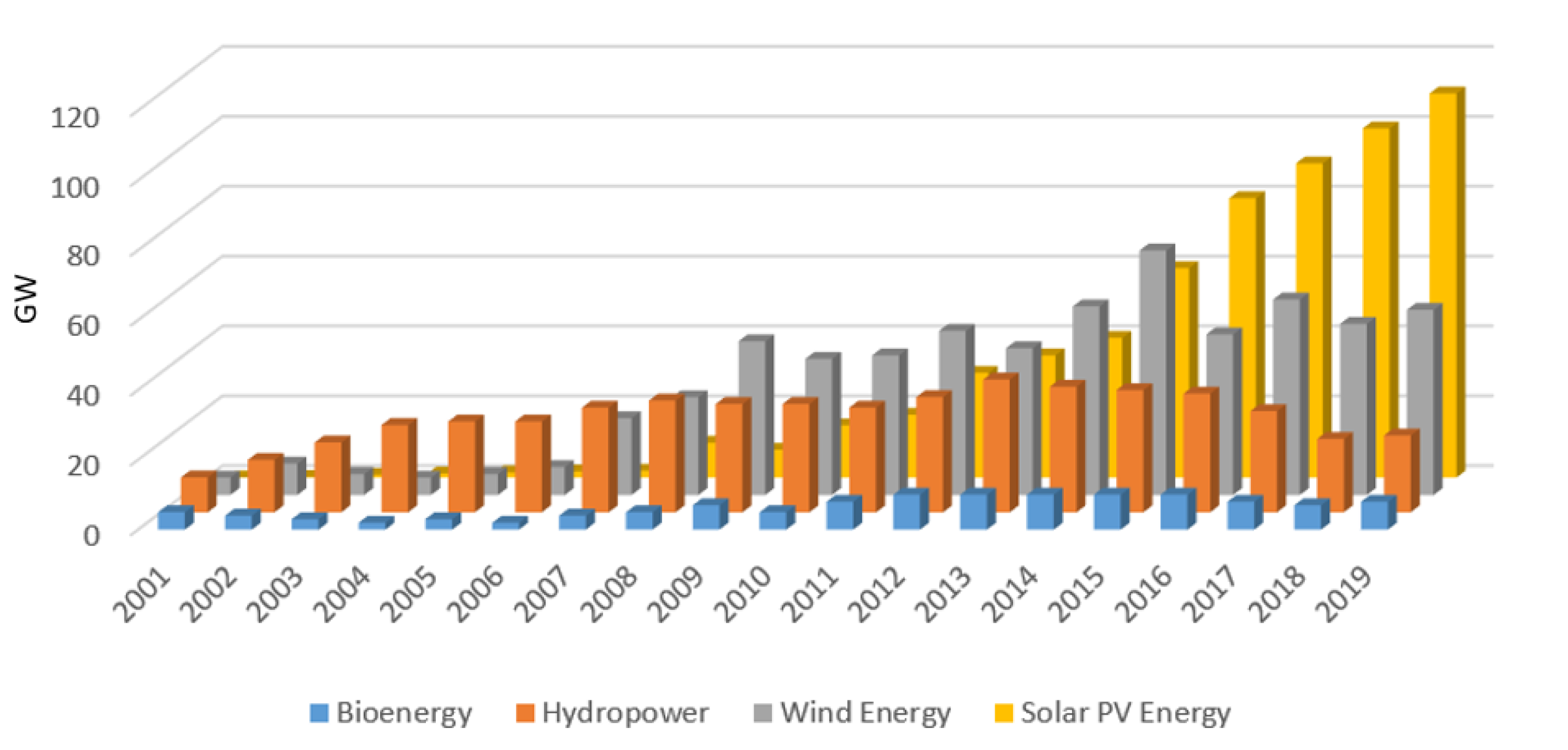
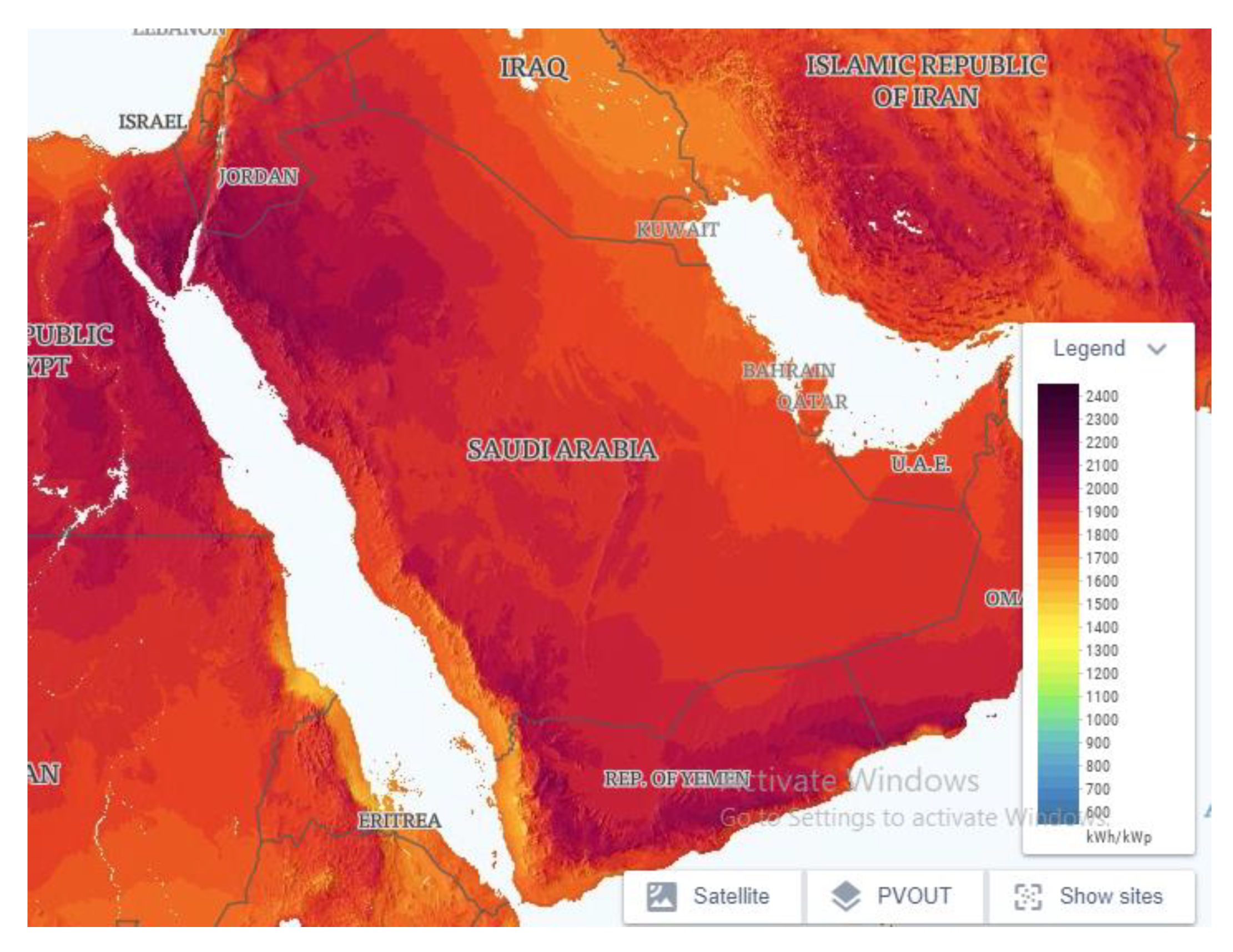
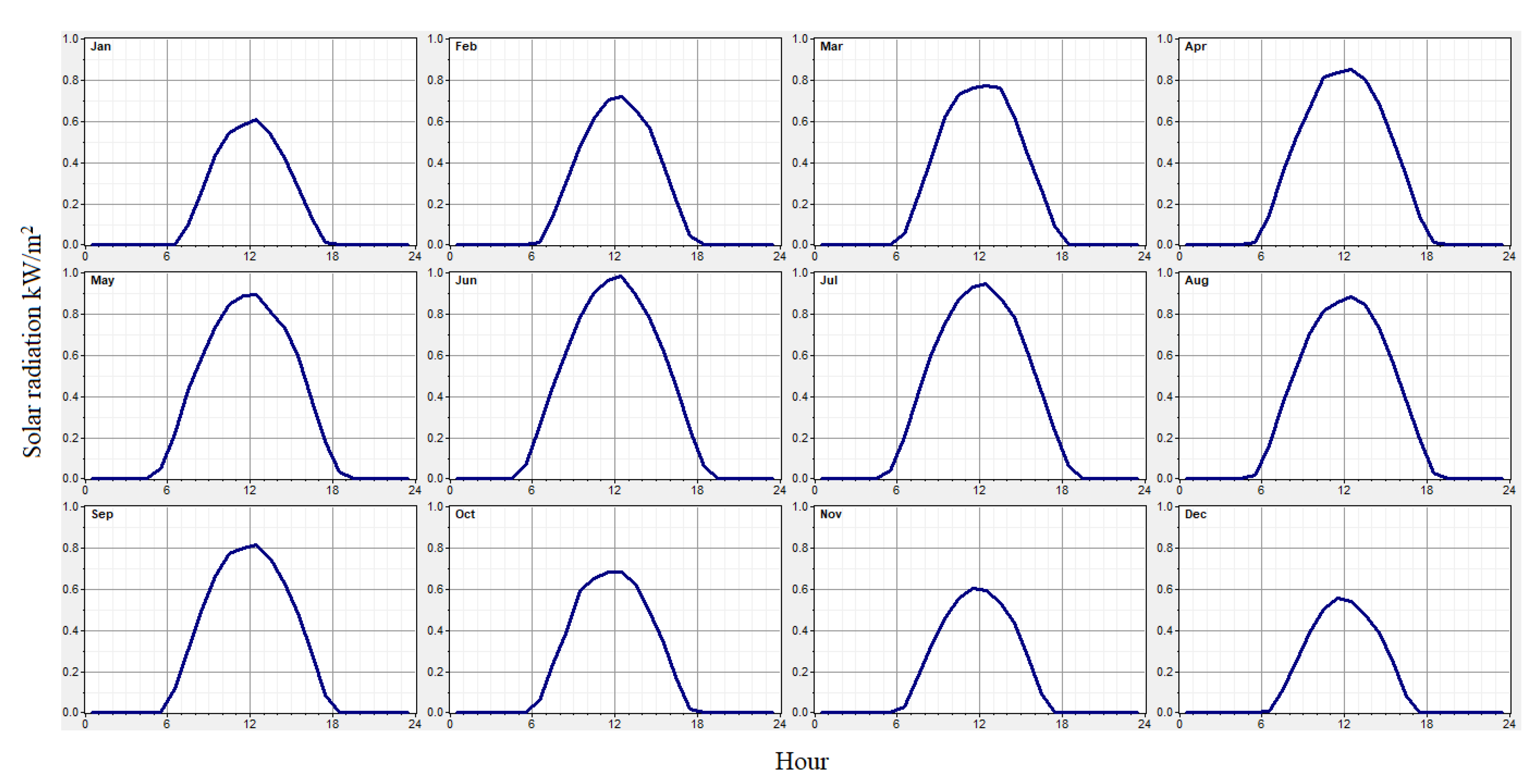




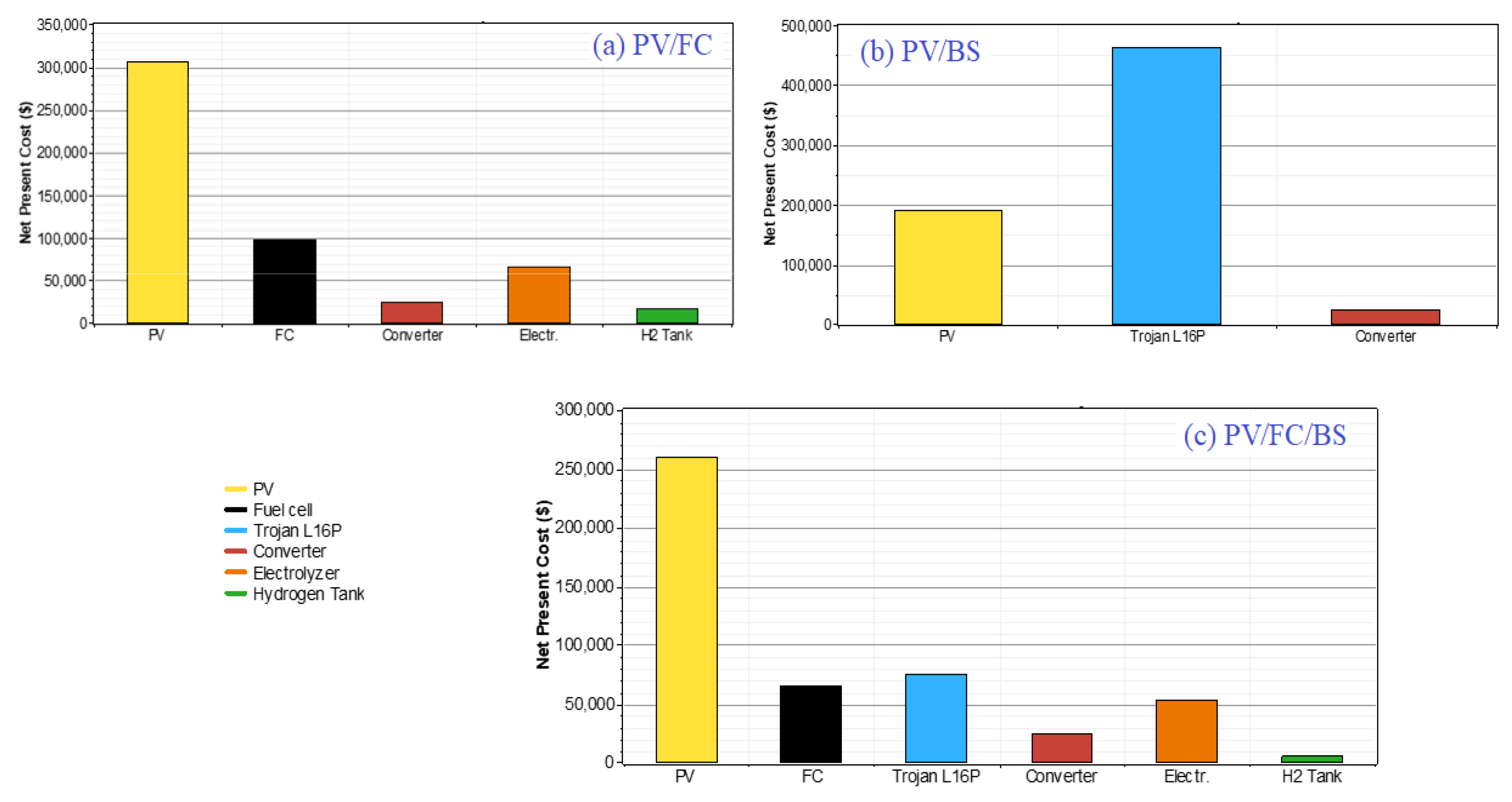

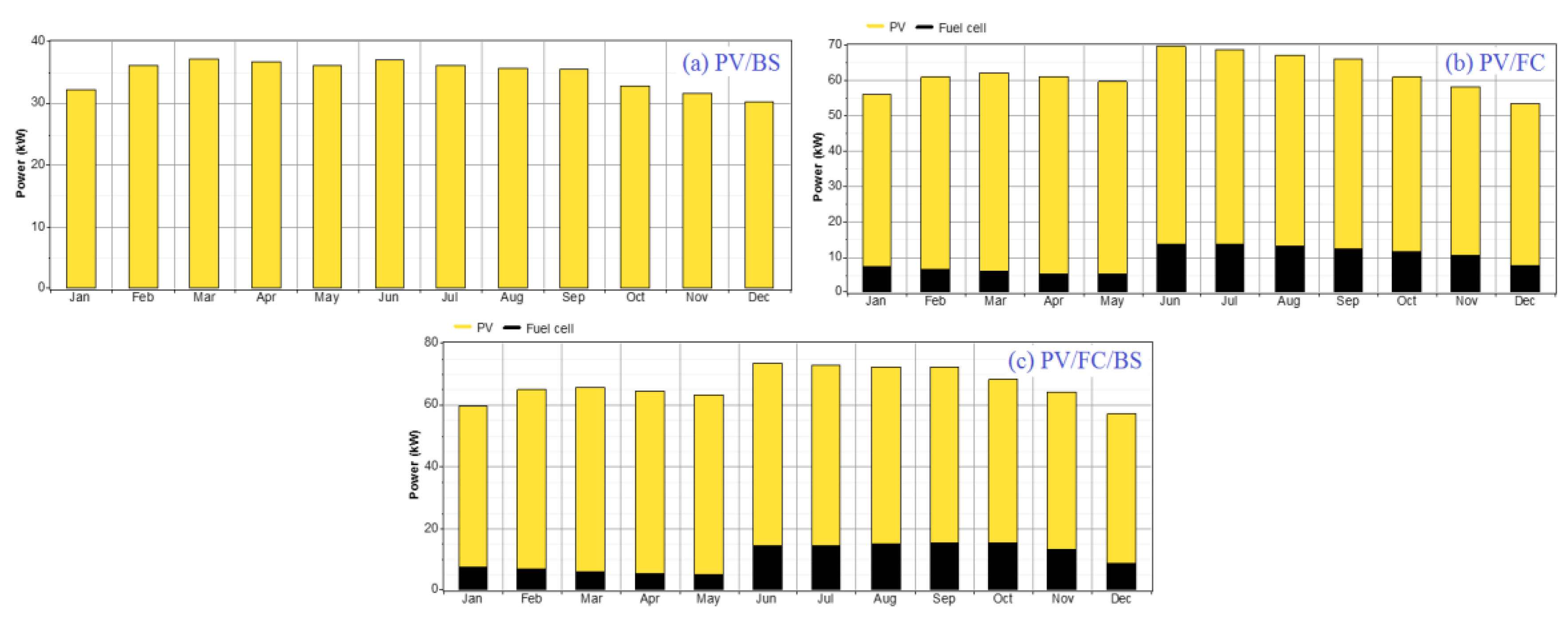

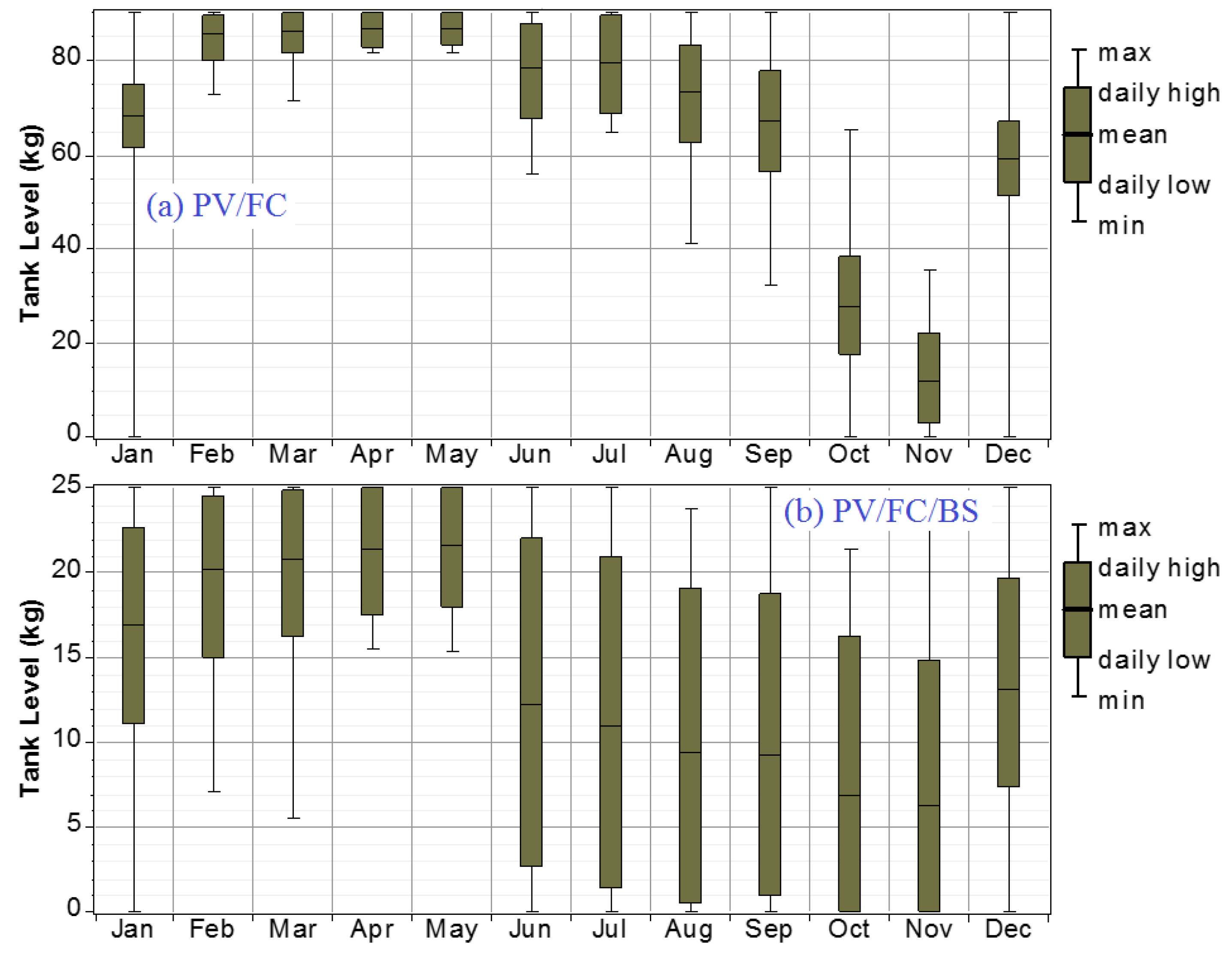
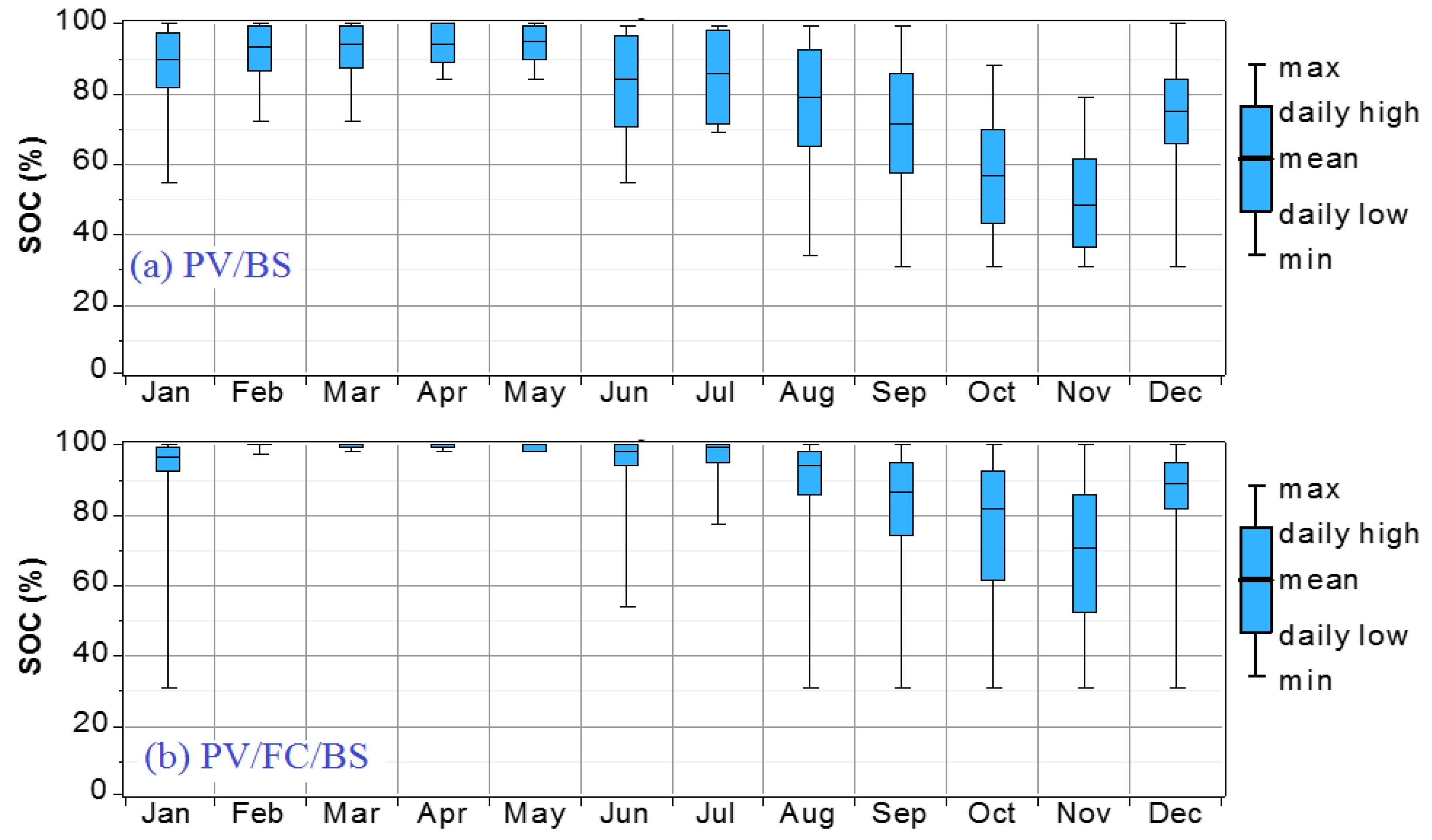
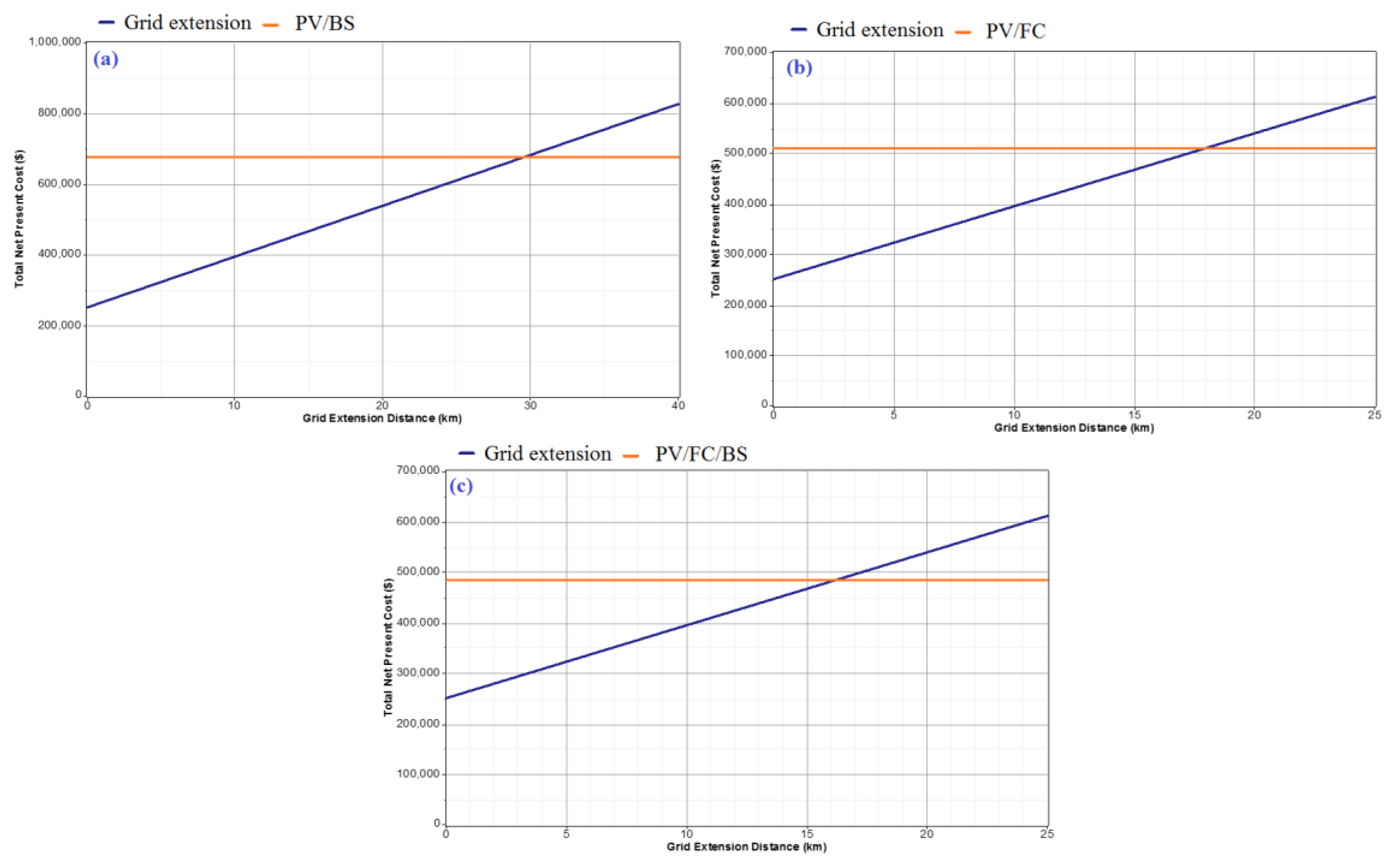
| Authors | Year | Location | Hybrid Configuration | Simulation Tools | NPC $ | COE $/kWh |
|---|---|---|---|---|---|---|
| Shafiqur et al. [22] | 2020 | Pakistan | PV/WT/Battery | HOMER® MATLAB | 47,398 | 0.309 |
| Habib et al. [23] | 2020 | Pakistan | PV/WT/Battery | HOMER® MATLAB | 28,620 | 0.311 |
| Shafik et al. [24] | 2020 | Egypt | Grid/PV/WT/ Diesel G. | HOMER® NEPALN | 9,670,000 | 0.117 |
| Shafik et al. [24] | 2020 | Egypt | Grid/PV/WT | HOMER® NEPALN | 9,970,000 | 0.177 |
| Shafik et al. [24] | 2020 | Egypt | Grid/PV/Diesel G. | HOMER® NEPALN | 2,770,000 | 0.124 |
| Shafik et al. [24] | 2020 | Egypt | Grid/PV | HOMER® NEPALN | 1,970,000 | 0.128 |
| Shafik et al. [24] | 2020 | Egypt | WT/Grid/Diesel G. | HOMER® NEPALN | 10,000,000 | 0.130 |
| Ziedan et al. [25] | 2020 | Egypt | PV/WT/Battery | HOMER® MATLAB | 3,461,264,640 | 0.202 |
| Ziedan et al. [25] | 2020 | Egypt | Grid/PV/WT | HOMER® MATLAB | 1,830,547,760 | 0.08 |
| Al-Ghussain et al. [26] | 2020 | Turkey | PV/WT/Pumped Hydro Storage/ Hydrogen Fuel Cell | HOMER® | 250,000 | 0.175 |
| Rezk et al. [13] | 2019 | Egypt | PV/battery | HOMER® | 109,856 | 0.059 |
| Rezk et al. [14] | 2019 | Egypt | PV/FC | HOMER® | 115,649 | 0.062 |
| Habib et al. [27] | 2019 | Pakistan | WT/Battery | HOMER® MATLAB | 14,846 | 0.309 |
| Fodhil et al. [28] | 2019 | Algeria | PV/Diesel/Battery | PSO HOMER® | 8640.1 | 0.37 |
| Jahangiri et al. [29] | 2019 | Iran | Grid/PV/VAWTs | PSO HOMER® | 84,200 | 0.496 |
| Aziz et al. [30] | 2019 | Iraq | PV/Hydro/Diesel/Battery | HOMER® | 113,201 | 0.054 |
| Aziz et al. [31] | 2019 | Iraq | PV/Diesel G./ Battery | HOMER® | 138,704 | 0.264 |
| César et al. [32] | 2019 | Spain | PV/WT/Biomass/H2/Fuel Cell | MPC, GA MATLAB Experiment | 21,161 | 0.123 |
| Awan [33] | 2019 | Saudi Arabia | PV/WT/Diesel/Battery | HOMER® | 8,130,000 | 0.164 |
| Akar et al. [34] | 2019 | Turkey | Grid/PV | HOMER® | 286,242 | 0.164 |
| Jamiu et al. [35] | 2019 | Nigeria | PV/WT//Diesel G./Battery | HOMER® | 259,354 | 0.218 |
| Goudarzi et al. [36] | 2019 | Iran | PV/WT/Battery | HOMER® | 676,345 | 0.274 |
| Shaahid et al. [37] | 2018 | Saudi Arabia | PV/WT/Battery | HOMER® | 35,449 | 0.226 |
| Component | Specification |
|---|---|
| Solar PV cells | |
| Model name | Generic flat-plate PV |
| Peak power | 1 kW |
| Slop | 28o |
| Ground reflection | 27% |
| Operating temperature | 46o |
| Efficiency | 14.7% |
| Capital cost | $1000 |
| Replacement cost | $1000 |
| O&M cost | $5/year |
| Lifetime | 25 years |
| Fuel cell | |
| Model name | Proton exchange membrane |
| Capital cost | 500 $/kW |
| Replacement cost | 450 $/kW |
| O&M cost | 0.02 $/h |
| Lifetime | 40,000 h |
| Efficiency | 90% |
| Batteries (BS) | |
| Model name | Trojan L16P |
| Nominal capacity | 360 Ah, 2.16 kWh |
| capital cost | 175 $/one unit |
| cost of replacement | 175 $/one unit |
| O&M cost | 5 $/year |
| Converter | |
| Capital cost | 500 $/kW |
| Replacement cost | 450 $/kW |
| O&M cost | $5/year |
| Lifetime | 15 years |
| Efficiency | 90% |
| Electrolyzer | |
| Model name | Bipolar, alkaline type |
| Capital cost | 300 $/kW |
| Replacement cost | 290 $/kW |
| O&M cost | 5 $/kW |
| Lifetime | 25 years |
| Efficiency | 85% |
| Hydrogen storage tank | |
| Capital cost | 200 $/kg |
| Replacement cost | 150 $/kg |
| O&M cost | 10 $/year. |
| Lifetime | 25 years. |
| PV (kW) | FC (kW) | No of Batteries | Conv. (kW) | Elect. (kW) | H2 Tank (kg) | Initial Cost ($) | Operating Cost ($/yr) | NPC ($) | COE ($/kWh) | |
|---|---|---|---|---|---|---|---|---|---|---|
| PV-B | 155 | n.a. | 640 | 30 | n.a. | n.a. | 282,200 | 17,958 | 667,493 | 0.164 |
| PV-FC | 250 | 35 | n.a. | 30 | 160 | 90 | 348,500 | 7339 | 510,128 | 0.124 |
| PV-FC-B | 235 | 30 | 144 | 30 | 130 | 25 | 334,200 | 6786 | 438,657 | 0.117 |
| Capital ($) | Replacement ($) | O&M ($) | Salvage ($) | Total ($) | |
|---|---|---|---|---|---|
| PV/FC/BS | |||||
| PV array | 235,000 | 0 | 25,877 | 0 | 260,877 |
| FC | 15,000 | 13,120 | 39,285 | −1659 | 65,746 |
| BS | 25,200 | 43,466 | 15,857 | −9825 | 74,697 |
| Converter | 15,000 | 12,920 | 0 | −3899 | 24,021 |
| Electrolyzer | 39,000 | 0 | 14,315 | 0 | 53,315 |
| H2 Tank | 5000 | 0 | 0 | 0 | 5000 |
| System | 334,200 | 69,506 | 95,334 | −15,383 | 483,657 |
| PV/BS | |||||
| PV array | 155,000 | 0 | 34,136 | 0 | 189,136 |
| Batteries | 112,000 | 295,608 | 70,474 | −13,746 | 464,336 |
| Converter | 15,000 | 12,920 | 0 | −3899 | 24,021 |
| system | 282,000 | 308,528 | 104,610 | −17,645 | 677,493 |
| PV/FC | |||||
| PV array | 250,000 | 0 | 55,058 | 0 | 305,058 |
| FC | 17,500 | 29,949 | 58,535 | −8554 | 97,430 |
| Converter | 15,000 | 12,920 | 0 | −3899 | 24,021 |
| Electrolyzer | 48,000 | 0 | 17,619 | 0 | 65,619 |
| H2 Tank | 18,000 | 0 | 0 | 0 | 18,000 |
| System | 348,500 | 42,869 | 131,212 | −12,453 | 510,128 |
| Item | Component | PV/BS | PV/FC | PV/FC/BS |
|---|---|---|---|---|
| Electrical production (kWh/yr) | PV | 304,166 (100%) | 490,590 (84%) | 461,155 (85%) |
| FC | n.a. | 91,002 (16%) | 81,410 (15%) | |
| Total | 304,166 (100%) | 581,592 (100%) | 542,565 (100%) | |
| Consumption energy (kWh/yr) | RO-unit | 187,307 (100%) | 187,105 (42%) | 187,134 (45%) |
| electrolyzer | n.a. | 256,623 (58%) | 227,153 (55%) | |
| total | 187,307 (100%) | 443,728 (100%) | 414,287 (100%) | |
| Excess electricity | (kwh/yr) | 79,069 (26%) | 117,063 (20.1%) | 105,439 (19.4) |
| Unmet load | (kwh/yr) | 3213 (1.7%) | 3414 (1.8%) | 3385 (1.8%) |
| Capacity shortage | (kwh/yr) | 3822 (2%) | 3978 (2.1%) | 3984 (2.1%) |
| Quantity | Units | PV/BS | PV/FC | PV/FC/BS |
|---|---|---|---|---|
| PV array | ||||
| Rated capacity | kW | 155 | 250 | 235 |
| Mean output | kW | 35 | 56 | 53 |
| Daily mean output | kwh | 833 | 1344 | 1263 |
| Capacity factor | % | 22.4 | 22.4 | 22.4 |
| Total production | kWh/yr | 304,166 | 490,590 | 461,155 |
| PV penetration | % | 160 | 258 | 244 |
| Hours of operation | hr/yr | 4382 | 4382 | 4382 |
| Levelized cost | $/kWh | 0.0282 | 0.0282 | 0.0257 |
| Fuel cell | ||||
| Hours of operation | hr/yr | n.a. | 3797 | 2973 |
| Number of starts | Starts/yr | n.a. | 573 | 545 |
| Operation life | yr | n.a. | 10.5 | 13.5 |
| Capacity factor | % | n.a. | 29.7 | 31 |
| Total production | kWh/yr | n.a. | 91,002 | 81,410 |
| Mean electrical output | kW | n.a. | 24 | 27.4 |
| Min. electrical output | kW | n.a. | 0.35 | 0.39 |
| Min. electrical output | kW | n.a. | 28.9 | 30 |
| Hydrogen consumption | kg/yr | n.a. | 5460 | 4885 |
| Specific fuel consumption | kg/kWh | n.a. | 0.06 | 0.06 |
| Fuel electrical input | kWh/yr | n.a. | 182,010 | 162,820 |
| Mean electrical efficiency | % | n.a. | 50 | 50 |
| Battery storage | ||||
| Number of batteries | 640 | n.a. | 144 | |
| Nominal capacity | kWh | 1382 | n.a. | 311 |
| Usable nominal capacity | kWh | 968 | n.a. | 218 |
| Autonomy | hr | 36.7 | n.a. | 8.27 |
| Lifetime throughout | kWh | 688,000 | n.a. | 154,800 |
| Energy in | kWh/yr | 114,462 | n.a. | 13,557 |
| Energy output | kWh/yr | 97,495 | n.a. | 11,523 |
| Storage depletion | kWh/yr | 202 | n.a. | 0 |
| Expected life | yr | 6.51 | n.a. | 10 |
| Hydrogen | ||||
| Total production | Kg/yr | n.a. | 5530 | 4895 |
| Levelized cost | $/kg | n.a. | 4.19 | 4.49 |
| Hydrogen tank autonomy | hr | n.a. | 114 | 31.6 |
© 2020 by the authors. Licensee MDPI, Basel, Switzerland. This article is an open access article distributed under the terms and conditions of the Creative Commons Attribution (CC BY) license (http://creativecommons.org/licenses/by/4.0/).
Share and Cite
Rezk, H.; Alghassab, M.; Ziedan, H.A. An Optimal Sizing of Stand-Alone Hybrid PV-Fuel Cell-Battery to Desalinate Seawater at Saudi NEOM City. Processes 2020, 8, 382. https://doi.org/10.3390/pr8040382
Rezk H, Alghassab M, Ziedan HA. An Optimal Sizing of Stand-Alone Hybrid PV-Fuel Cell-Battery to Desalinate Seawater at Saudi NEOM City. Processes. 2020; 8(4):382. https://doi.org/10.3390/pr8040382
Chicago/Turabian StyleRezk, Hegazy, Mohammed Alghassab, and Hamdy A. Ziedan. 2020. "An Optimal Sizing of Stand-Alone Hybrid PV-Fuel Cell-Battery to Desalinate Seawater at Saudi NEOM City" Processes 8, no. 4: 382. https://doi.org/10.3390/pr8040382
APA StyleRezk, H., Alghassab, M., & Ziedan, H. A. (2020). An Optimal Sizing of Stand-Alone Hybrid PV-Fuel Cell-Battery to Desalinate Seawater at Saudi NEOM City. Processes, 8(4), 382. https://doi.org/10.3390/pr8040382







